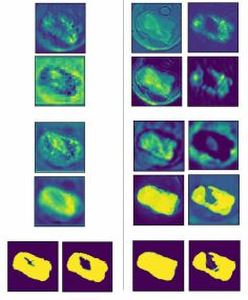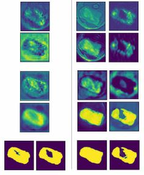Information
- Publication Type: Master Thesis
- Workgroup(s)/Project(s): not specified
- Date: July 2020
- Date (Start): 10. December 2019
- Date (End): 25. July 2020
- TU Wien Library:
- Second Supervisor: Katja Bühler
- Diploma Examination: 5. August 2020
- Open Access: yes
- First Supervisor: Eduard Gröller
- Pages: 118
- Keywords: tumor segmentation, deep learning
Abstract
The automatic segmentation of tumors on different imaging modalities supports medical experts in patient diagnosis and treatment. Magnetic resonance imaging (MRl), Computed Tomography (CT), or Positron Emission Tomography (PET) show the tumor in a different anatomical. functional, or molecular context. The fusion of this multimodal information leads to more profound knowledge and enabler more precise diagnoses. So far, the potential of multimodal data is only used by a few established segmentation methods. Moreover, much less is known about multimodal methods that provide several multimodal-specific tumor segmentations instead of single segmentations for a specific modality. This thesis aims to develop a segmentation method that uses multimodal context to improve t the modality-specific segmentation results. For the implementation, an artificial neural network is used, which is based on a fully convolution neural network. The network architecture has been designed to learn complex multimodal features to predict multiple tumor segmentations on different modalities efficiently. The evaluation is based on a dataset consisting of MRl aid PET /CT scans of soft soft tissue tumors. The experiment investigated how different network architectures, multimodal fusion strategies, and input modalities affect the segmentation results. Tbc investigation showed that multimodal rondels lead to significantly better results than models for single modalities. Promising results have been achieved with multimodal models that segment several modality-specific tumor contours simultaneously.Additional Files and Images
Weblinks
BibTeX
@mastersthesis{Neubauer2020,
title = "Volumetric Image Segmentation on Multimodal Medical Images
using Deep Learning",
author = "Theresa Neubauer",
year = "2020",
abstract = "The automatic segmentation of tumors on different imaging
modalities supports medical experts in patient diagnosis and
treatment. Magnetic resonance imaging (MRl), Computed
Tomography (CT), or Positron Emission Tomography (PET) show
the tumor in a different anatomical. functional, or
molecular context. The fusion of this multimodal information
leads to more profound knowledge and enabler more precise
diagnoses. So far, the potential of multimodal data is only
used by a few established segmentation methods. Moreover,
much less is known about multimodal methods that provide
several multimodal-specific tumor segmentations instead of
single segmentations for a specific modality. This thesis
aims to develop a segmentation method that uses multimodal
context to improve t the modality-specific segmentation
results. For the implementation, an artificial neural
network is used, which is based on a fully convolution
neural network. The network architecture has been designed
to learn complex multimodal features to predict multiple
tumor segmentations on different modalities efficiently.
The evaluation is based on a dataset consisting of MRl aid
PET /CT scans of soft soft tissue tumors. The experiment
investigated how different network architectures, multimodal
fusion strategies, and input modalities affect the
segmentation results. Tbc investigation showed that
multimodal rondels lead to significantly better results than
models for single modalities. Promising results have been
achieved with multimodal models that segment several
modality-specific tumor contours simultaneously. ",
month = jul,
pages = "118",
address = "Favoritenstrasse 9-11/E193-02, A-1040 Vienna, Austria",
school = "Research Unit of Computer Graphics, Institute of Visual
Computing and Human-Centered Technology, Faculty of
Informatics, TU Wien",
keywords = "tumor segmentation, deep learning",
URL = "https://www.cg.tuwien.ac.at/research/publications/2020/Neubauer2020/",
}

 image
image Master Thesis
Master Thesis Poster
Poster


